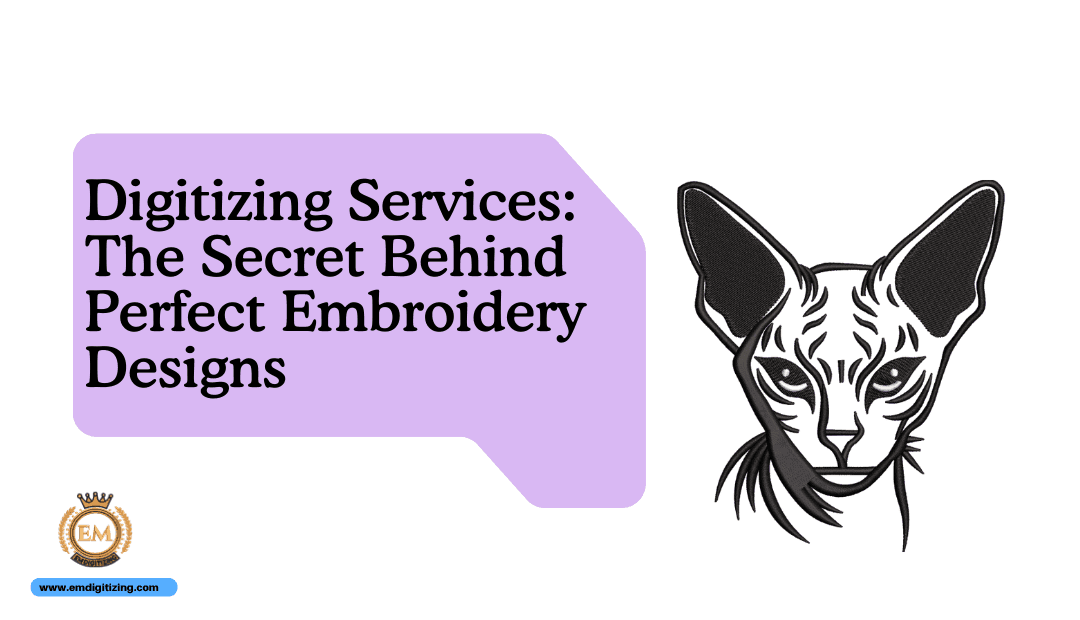Embroidery has long been admired for its beauty, durability, and ability to elevate fabric into something extraordinary. However, in the age of technology, embroidery has gone beyond simple stitching. Businesses, fashion brands, and hobbyists now rely on digitizing services to create professional, accurate, and visually stunning designs.
Digitizing services are the hidden force behind flawless embroidery. They transform artwork, logos, or custom illustrations into stitch-ready files that embroidery machines can understand. Without this process, even the best artwork cannot translate well onto fabric. In this blog, we’ll explore how digitizing services unlock perfect embroidery designs, the benefits they offer, and why they are essential for anyone looking to achieve professional embroidery results.
What Are Digitizing Services?
Digitizing services involve converting artwork into a digital embroidery file format. These files contain detailed instructions on stitch type, direction, length, and density. Specialized digitizing software, combined with professional expertise, ensures the design is optimized for embroidery machines.
Unlike regular graphic files (JPEG, PNG, or vector art), embroidery files carry stitching commands tailored for specific fabrics and threads. This makes digitizing services the most important step in achieving accurate and high-quality embroidery.
Why Digitizing Is Essential for Embroidery Success
Perfect embroidery doesn’t happen by chance. It requires careful planning and technical adjustments that only digitizing services can provide. Here’s why digitizing is the secret behind embroidery excellence:
1. Precision and Accuracy
Digitizing ensures every stitch is carefully mapped. Whether it’s a corporate logo or intricate artwork, digitizing services maintain design integrity while making it embroidery-friendly.
2. Adaptability to Fabrics
Not all fabrics behave the same under stitching. A design that looks great on cotton may distort on silk. Digitizing services account for fabric type, adjusting stitch density and underlay to guarantee smooth results.
3. Professional Quality Results
Embroidery is often used for branding, uniforms, and special projects where perfection matters. Digitizing ensures the design appears sharp, durable, and visually appealing.
4. Saves Time and Costs
Poorly digitized files can cause thread breaks, machine jams, and wasted materials. Professional digitizing services eliminate these issues, saving both time and production costs.
The Process of Digitizing Services Explained
Step 1: Analyzing the Artwork
The first step is reviewing the artwork to ensure it is embroidery-friendly. Designs with too much detail may require simplification for clarity.
Step 2: Choosing Stitch Types
Different parts of a design need different stitch types. Satin stitches work for text, fill stitches for larger areas, and running stitches for outlines.
Step 3: Adjusting Stitch Density and Direction
Digitizers control density to prevent stiffness or gaps. Stitch direction is also optimized for a smoother flow and better finish.
Step 4: Setting Underlay Stitches
Underlay stabilizes the fabric and prepares it for top stitches. This foundation prevents puckering and shifting.
Step 5: Test Run and Refinement
Before final delivery, digitizers run test samples to identify any issues and refine the file for flawless embroidery.
Benefits of Using Professional Digitizing Services
High-Quality Embroidery Every Time
Professional digitizers know how to balance design complexity with embroidery limitations, resulting in consistent quality.
Customization for Every Project
From small logos to large patterns, digitizing services adapt to any project requirements.
Enhanced Branding Impact
For businesses, a poorly stitched logo can damage brand reputation. Professional digitizing ensures your brand looks polished and professional.
Durability and Longevity
Well-digitized designs withstand repeated washing and wear, maintaining their beauty for years.
Common Mistakes Without Digitizing Services
-
Using low-resolution artwork that doesn’t translate well into stitches.
-
Ignoring fabric type, leading to puckering and distortion.
-
Improper stitch density, causing stiffness or gaps.
-
Skipping underlay, resulting in uneven embroidery.
-
Relying on auto-digitizing software, which lacks precision for complex designs.
Avoiding these mistakes is only possible through expert digitizing services.
How Digitizing Services Support Businesses
1. Corporate Branding
Logos on uniforms, caps, and promotional items require precise embroidery. Digitizing ensures logos look sharp, enhancing brand identity.
2. Fashion Industry
Trendy apparel and custom wear depend heavily on detailed embroidery. Digitizing services keep up with evolving designs and fashion needs.
3. Sports Teams and Events
Team logos, numbers, and event merchandise need flawless embroidery for a professional look. Digitizing ensures accuracy in every stitch.
4. Personalized Gifts and Keepsakes
From monograms to family crests, digitizing services make personalized embroidery projects possible.
The Future of Digitizing Services
As technology evolves, digitizing services are becoming more advanced. Artificial intelligence (AI) and automation are speeding up the process, but professional digitizers remain essential for ensuring accuracy and quality. With the rise of custom apparel, e-commerce, and branding, digitizing will continue to play a central role in embroidery success.
Conclusion
Digitizing services are the backbone of perfect embroidery designs. They bridge the gap between creative ideas and machine execution, ensuring every stitch reflects precision and professionalism. Whether you’re running a business, designing fashion, or creating personal projects, investing in professional digitizing services guarantees exceptional results. For those seeking reliable and expert solutions, Emdigitizing is a trusted partner for flawless embroidery.
FAQs
Q1. What makes digitizing services different from regular graphic design?
Graphic design creates visuals for screens or print, while digitizing translates designs into stitch-ready instructions for embroidery machines.
Q2. Can any image be digitized for embroidery?
Almost any image can be adapted, but highly complex designs may require adjustments for embroidery-friendly results.
Q3. Do digitizing services work with all types of fabrics?
Yes, professional digitizers adjust stitch types and density based on fabric type, ensuring durability and clarity.
Q4. Why not use auto-digitizing software instead of services?
Auto-digitizing software lacks the precision of professional expertise, often resulting in poor-quality embroidery.
Q5. How long does the digitizing process take?
It depends on design complexity. Simple logos may take a few hours, while intricate artwork can take longer.

